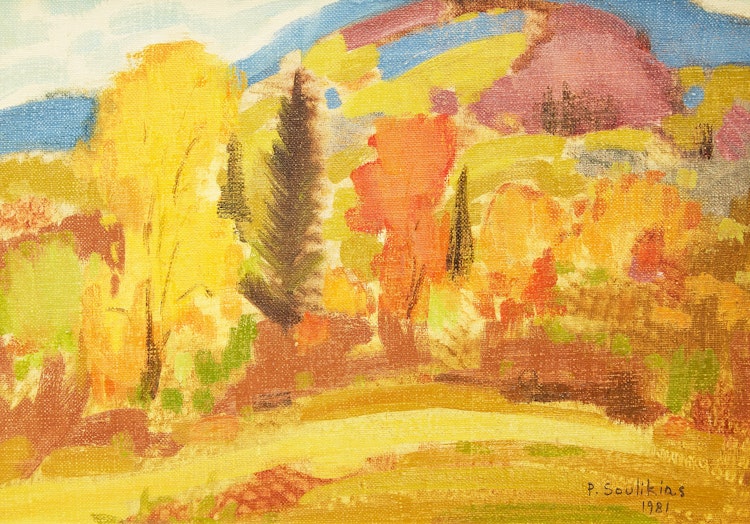Ste-Adèle, Que. by Paul Soulikias

Paul Soulikias
Ste-Adèle, Que.
oil on canvas
signed and dated 1981 lower right; titled on the reverse
9 x 12 ins ( 22.9 x 30.5 cms )
Auction Estimate: $300.00 - $400.00
Price Realized $252.00
Sale date: August 23rd 2022
La galerie d’art Gilles Brown, Montreal
Private Collection, Toronto
Share this item with your friends
Paul Soulikias
(1926)
Colour, composition, the inner character and poetry of the subject for the artistic rendering of Canadian nature and all natures: These are the characteristics of Paul Soulikias`s art observed by Canadian and Greek art critics as well as fellow artist painters since 1965. With a harmonization between artistic form and subject content, P. Soulikias communicates the beauty of art with an optimism which most of the time is expressed in celebrating nature and life. However when the subject demands it, he can be sombre and critical.
P. Soulikias works with all media, but his main medium is oil. He paints any subject that appeals to him
Paul (Paleologos) Soulikias was born in Komotini, Thrace, Greece in 1926 but grew up in Volos, Thessaly. His father was from Fanari, a small Thessalian town, and his mother, a refugee from Eastern Thrace. As a child, teenager and young man, he lived through the horror of the German Occupation and its troubled aftermath in Greece.
The times fell short in satisfying young Paul`s innate capabilities which consisted of a keen visual perception, a strong mathematical intelligence and a vivid imagination. No education was accessible to cultivate his raw artistic talent.
In the end, it was these very capabilities that gave him the strength to overcome the insurmountable obstacles of his life and study art. As soon as the Germans left Greece, he found employment and began to study drawing and painting. First, on his own, he managed to depict the likeness of his subjects, such as landscapes and portraits. Yet he knew very well the great demands of art. He had great respect for art and wished to be honest with it and with himself. Consequently, he went to Athens and worked his way through the ABC School of Art and continued to expand his knowledge. Thus he was ready to enter the most difficult of all schools, that of Nature as he often calls it. Working at this school, he mastered the knowledge of painting all subjects while handling them creatively. He read literature, loved music and all arts.
In 1956, he went to Paris where he intensively studied the great masters of the Louvre. He painted scenes along the river Seine. He met and observed many artists at work next to him.
He returned to Greece and in 1959 he left for Canada with a broad knowledge of painting. This knowledge combined with his strong intellectual capabilities and his creative talent enabled him to conquer the magnificent Canadian nature and to render it artistically with a fresh look.

